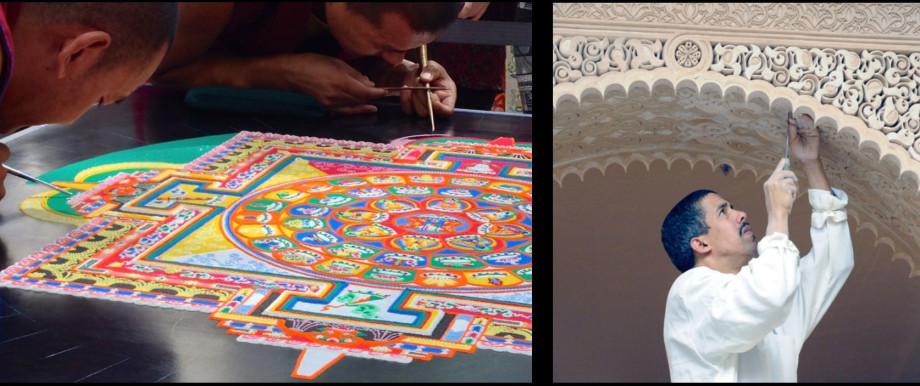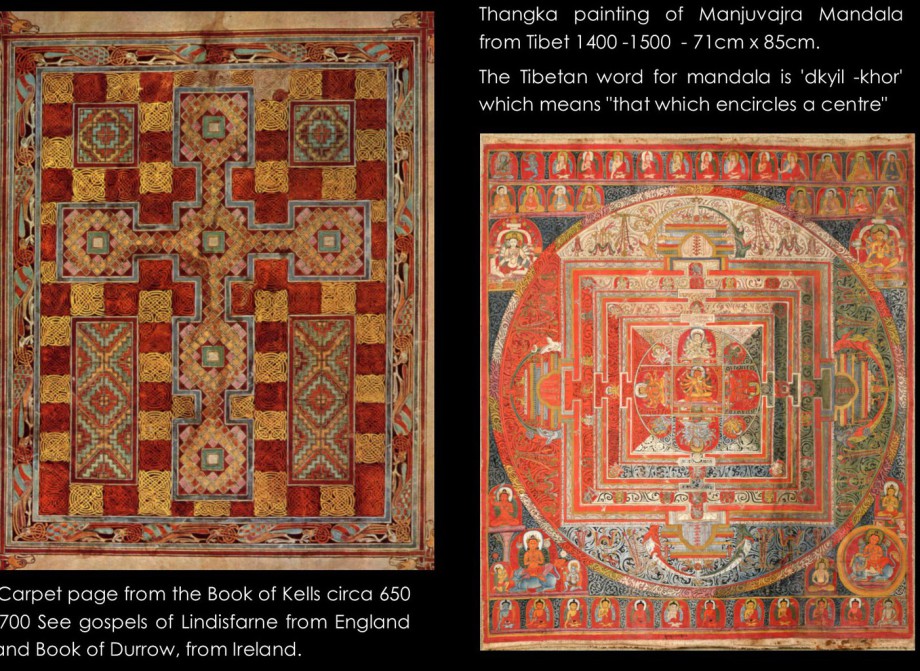Sacred Geometry Mandala Art School
What is a mandala?
From an enlightened perspective, mandala can be understood as a microcosm of the universe and/or sometimes depicting a principal deity as a metaphysical concept.
The most common translation for mandala is 'circle' or more specifically 'sacred circle. The word mandala comes from Sanskrit which is an ancient Indic language from the Asain sub-continent. The Shruti Hindu scriptures and all the classical Indian epic poems were written in Sanskrit over 2500 years ago. In Hinduism and Buddhism mandala are created as spiritual and ritual symbols representing the Universe or a generic term for any plan, chart or geometric pattern that represents the cosmos both metaphysically or symbolically. The circular pattern or circle form is ubiquitous in the Arts and Architecture of antiquity.
The English word for mandala could mean something like Rose Window or Wheel of Life. If you happen to practice Hinduism or live in the mountains of Tibet you would know the word mandala. For most of us in the West, the word can be encountered in many ways however most commonly through Art School, Architecture Studies, the Decorative Arts, Tibetan Buddhism or through the study of Psychology and the work of Carl Jung and now in Art Therapy and Holistic thought too.
It is understandable the mandala is becoming more common in the West because of its intricate and aesthetically pleasing and contemplative patterning. It describes the maker's anthropo-cosmic universe and mandala tends to be governed by the two major forms of geometry, plane and projective, with circles, squares, and triangles creating various combinations and tesselations. The inherent simplicity within an apparent complex pattern makes the process of making mandala accessible. Find the patterns that are 'universal' across world traditions both ancient and modern and see pattern and structure in the created universe as evidence for intelligence.
mandala मण्डल - 'the way to the cream'
Language and Etymology (the root meaning of words) are important in understanding the nature of the words we use to describe things. It is interesting to explore the Sanskrit meaning of mandala and you will find that both 'manda' मण्ड and 'la' ल also have meanings so 'manda' can be translated as; the top of something, the cream of the milk, an elixir or tonic and 'la' is a finite verb and is used in front of words like 'lamate' which means emotion to delight in something or suggest a direction or way. The word 'dala' means petal, portion or a kind of honey produced from petals. The word 'man' means 'to think' and mandala is used to describe the path of a planet.
The word mandala can be understood to mean 'the way to cream' or 'map to goodness'. Certainly it may help you to consider something special and significant about a mandala designed intensionally to invoke a metaphysical concept. In the context of a traditional Tibetan mandala the 'cream' could mean reaching buddhahood, a symbol in the centre of the circle and a means to achieve peace in life. In many cultures across the world the centre of the circle in saved for a principal deity or abstract concept. In the centre of the beautiful North Rose window at Chatre's Cathedral the centre of the circle sits a Mother and Child.
A Navajo man creates a Medicine Wheel with sand. This is a mandala made with coloured sands, ochre, charcoal and chalk. The circle is quartered to represent four cardinal directions. In Mysore, a lady creates a ritual mandala pattern outside her home. This kind of art is known as Rangoli or Kolam and designed specifically to attract positive energy during the festival of Diwali.




